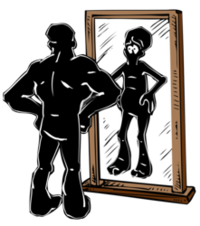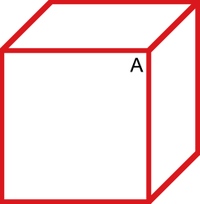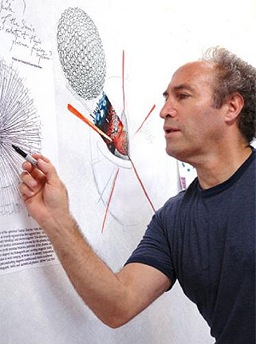Living In A Unified Field

“Scientists – now familiar with field theory, ecological dynamics and the transactional nature of perception – can no longer see man as the independent observer of an alien and rigidly mechanical world of separate objects. The clearly mystical sensation of self-and-universe, or organism-and-environment, as a unified field or process seems to fit the facts.”
–Alan W. Watts (English-born American Philosopher, Writer, Speaker and Expert in Comparative Religion, 1915-1973)

“Behold the Spirit: A Study in the Necessity of Mystical Religion” (Alan W. Watts)
Your Latent Powers

“Faculty X is simply that latent power in human beings possess to reach beyond the present. After all, we know perfectly well that the past is as real as the present, and that New York and Singapore and Lhasa and Stepney Green are all as real as the place I happen to be in at the moment. Yet my senses do not agree. They assure me that this place, here and now, is far more real than any other place or any other time. Only in certain moments of great inner intensity do I know this to be a lie. Faculty X is a sense of reality, the reality of other places and other times, and it is the possession of it — fragmentary and uncertain though it is — that distinguishes man from all other animals.”
–Colin Wilson (English Novelist and Writer on Philosophy, Sociology and the Occult, 1931-)
Subject and Object

“In the gap between subject and object lies the entire misery of humankind.”
–Jiddu Krishnamurti (Indian Spiritual Teacher, 1895-1986)
“
The First and Last Freedom” (J. Krishnamurti)
That Which Cannot Be Seen

“Perceive that which cannot be seen with the eye.”
–Miyamoto Musashi (a.k.a. Shinmen Takezō, a.k.a. Miyamoto Bennosuke, a.k.a Niten Dōraku, Japanese Samurai, Swordsman and Founder of the Hyōhō Niten Ichi-ryū or Niten-ryū style of Swordsmanship and Author of The Book of Five Rings (五輪書 Go Rin No Sho), on Strategy, Tactics, and Philosophy, c.1584-1645)

“The Book of Five Rings (Shambhala Classics)” (Miyamoto Musashi)
Women and the “Over-Attractive” Male
Here’s another one of those pieces of research that leave you thinking, “Didn’t I already know that?”
Researchers at the University of Central Lancashire in England have found that men who are good-looking, single and earn a large income are not as attractive as good-looking men with an average job and income. It may be important that the research was done in England: social status is still far more heavily engrained in society than it is in the United States or Australia.
The research was published in the journal Personality and Individual Differences, and examined how 186 heterosexual female students weighed up the male physical attractiveness and socioeconomic status when considering a long-term relationship. The average age of the test subjects was 23, and they were asked to look at personal ads of a number of men and to rank them in terms of attractiveness as a long-term partner. Each advertisement showed a photograph and provided basic information about the man’s age, occupation and what he was seeking in a partner.
The images of the men had previously been measured on a subjective scale of attractiveness. The men were randomly allocated to eighteen different occupations that varied from an architect and company director to a waiter, postman and gardener.
The researchers found that men who were rated as physically highly attractive but had medium social status, scored better than highly attractive men of high status. The authors speculated that the highly attractive high status men might have been thought to be more likely to be unfaithful in relationships or to be “too good to be true.” I was reminded here of a piece that I wrote in November: many people probably make mistakes in evaluating the potential of relationships simple because they under-estimate themselves.
Not only would it be good to repeat this research outside England, but it would also be a good idea to do similar experiments with women and people with different sexual orientations. There is some research that men at that age tend to make more superficial evaluations about potential partners.
The take home message: don’t try to make yourself look better than you are, it may backfire; don’t under-estimate yourself and look below the surface when making any important decision.
And Fabio, eat your heart out!
“Men in general judge more by the sense of sight than by the sense of touch, because everyone can see, but only a few can test by feeling. Everyone sees what you seem to be, few know what you really are, and those few do not dare take a stand against the general opinion.”
–Niccoló Machiavelli (Italian Writer and Philosopher, 1469-1527)
“Judgment and love are opposites. From one comes all the sorrows of the world. From the other comes the peace of God. Judgment will bind my eyes and make me blind.”
–A Course in Miracles (Book of Spiritual Principles Scribed by Dr. Helen Schucman between 1965 and 1975, and First Published in 1976)
Beer Goggles
With Christmas coming, your humble reporter felt it important to share some critically important research from the cutting edge of science.
Beer goggles is a Britishism to describe the infamous phenomenon by which “ugly” people are magically transformed into “beauties” as more alcohol is consumed. An effect that normally only lasts until the following morning. A couple of years ago the BBC ran an article on this common observation with the catchy title, ‘Beauty is in the eye of the beer holder!’
Your humble reporter has – of course – never experienced the phenomenon for himself, but he was nonetheless impressed to hear that even beer goggles has now succumbed before the onslaught of the scientific method.
Researchers at Manchester University report that while beauty is indeed in the eye of the beholder (beer-holder?), the amount of alcohol consumed is not the only factor. They have identified some additional factors including the level of light in the bar, pub or club, the drinker’s own eyesight and the room’s smokiness. The physical distance between two people is also a factor.
Just to prove that this is real science, the researchers have generated a smart looking equation:
This is the key to the magic formula:
An = number of units of alcohol consumed
S = smokiness of the room (graded from 0-10, where 0 clear air; 10 extremely smoky)
L = luminance of ‘person of interest’ (candelas per square meter; typically 1 pitch black; 150 as seen in normal room lighting)
Vo = Snellen visual acuity (6/6 normal; 6/12 just meets driving standard)
d = distance from ‘person of interest’ (meters; 0.5 to 3 meters)
You can use the formula to calculate a final score, ranging from less than one – where there is no beer goggle effect – to more than 100. The higher the score, the higher the chance that the esthetically challenged will appear more attractive.
The leader of the research team, Nathan Efron, Professor of Clinical Optometry at the University of Manchester, had this to say: "The beer goggles effect isn’t solely dependent on how much alcohol a person consumes, there are other influencing factors at play too… For example, someone with normal vision, who has consumed five pints of beer and views a person 1.5 meters away in a fairly smoky and poorly lit room, will score 55, which means they would suffer from a moderate beer goggle effect."
But why, one wonders, would alcohol have the effect of making other people more attractive? After all the disinhibitory effects of alcohol can also make people aggressive, and the drinker will likely be less attractive to the people around him. Unless, of course, they are in a similar state. And why should less visual acuity make others more attractive? We could probably construct a model based on evolutionary psychology, but inquiring minds need to know.
Your reporter was left with a question: at a time when everyone in academia is fighting over a dwindling research budget, who on earth funded this research? Then he found the answer: the eye care company Bausch & Lomb PureVision.
But come to think of it, isn’t this the opposite of the result that the company would have wanted?
Don’t Underestimate Your Attractiveness!

I wonder how many readers have ever been in a social setting and been a bit depressed by how good-looking everybody else seems to be? I’ve seen quite a number of people who by anyone’s standards were attractive individuals, but who were quite convinced that they were not.
At this point most proponents of pop psychology would jump in and say, “Well he’s got low self-esteem and we need to fix that.” They would probably recommend some exercise involving a mirror and telling him or herself how beautiful, attractive, valuable or special they are.
And they would be dead wrong.
This misperception about the attractiveness of other people is an evolutionary trick that will not be much helped by any number of affirmations.
A very interesting and well-executed study from the University of Texas will be published in next month’s issue of Evolution and Human Behavior. Sarah Hill, a psychologist in David Buss’ evolutionary psychology laboratory. Her research has shown that people of both sexes believe that the sexual competition that they face is stronger than it really is. She beieves that this is useful: it makes people try harder to attract or keep a mate.
What Sarah did was to show heterosexual men and women photographs of people. She asked them to rate both how attractive those of their own sex would be to members of the opposite sex, and also how attractive the members of the opposite sex were. She then compared the scores for the former with the scores for the latter, seen from the other side. Men thought that the men they were shown were more attractive to women than they really were, and women thought the same of the women.
She had predicted the outcome of the study based on a theory developed in the same laboratory by Martie Haselton and David Buss. It is called error-management theory: the idea that when people make errors of judgment hey always tend to make the error that is going to be least costly. Research has shown something to which many women can attest: men often tend to misinterpret innocent friendliness as a sign that women are sexually interested in them. Haselton and Buss reasoned that men who are trying to decide if a woman is interested sexually could err in one of two ways. They can mistakenly believe that she is not interested, in which case they will not bother trying to have sex with her; or they can mistakenly believe she is interested, try, and be rejected. Trying and being rejected comes at relatively little cost. However, form an evolutionary perspective, not trying at all could lead the major cost of not being able to spread their DNA around.
The theory is that there is an opposite bias in women’s errors: They tend to undervalue signs that a man is interested in a committed relationship. The evolutionary argument would be that if she guesses wrongly about a man’s intentions, she might have to raise a child on her own.
However, when it comes to assessing physical attractiveness, man and women make the same errors.
We always need to be a bit wary about pushing the perspectives of evolutionary psychology too far. I think that they are valuable, but that we can get into trouble if we apply their insights too liberally: humans are complex creatures who are continuing to evolve rapidly. We are different in every way from the people of a thousand years ago.
But this is a very useful insight into why some many people feel to see themselves as they are.
The moral of the story: have courage in initiating new relationships, and look at the whole person: physical, psychological, social, subtle and spiritual.
And don’t forget to use your intuition: the surest guarantor of making the right steps in relationships.
“I never saw an ugly thing in my life: for let the form of an object be what it may, light, shade, and perspective will always make it beautiful.”
–John Constable (English Landscape Painter, 1776-1837)
Memes and Magical Thinking
There were so many excellent papers at this year’s British Association Festival of Science, that I still haven’t had been able to comment on all of them, but here’s another one that I found interesting for two reasons.
Bruce Hood, who is Professor of Experimental Psychology at the University of Bristol, presented an interesting paper on the near-Universality of superstitious beliefs and magical thinking. In his view people are naturally biased to accept a role for the irrational, and magical thinking is hard-wired into our brains.
Magical thinking is invaluable to an artist: being able to make new connections is the key to their creations. But it has long been argued that either rejecting or accepting magical thinking may both be potential triggers of psychopathology. I once treated a young Israeli man who, during the first Gulf War, became convinced that Saddam Hussein was personally writing the Israeli man’s name on each Scud missile. He refused to remove his gas mask, and eventually his thinking became delusional.
Bruce’s conclusion is that magical thinking and a belief in the supernatural is an evolutionary adaptation. He goes on to argue that the rabid atheists who blame organized religion for the spread “illogical thinking” and a belief in the supernatural and are just plain wrong. Instead he contends that religion may capitalize on a natural bias to assume the existence of supernatural forces.
In a world in which religious fundamentalism is something of a challenge, he had this to say:
“It is pointless to get people to abandon their belief systems because they operate at such a fundamental level that no amount of rational evidence or counter evidence is going to be taken on board to get people to abandon these ideas.”
Bruce has carried out studies to show how the brains of even young babies organize sensory information. They supply what is missing and use the information to generate theories about the world.
In adulthood, the visual centers of the brain still fill in details that are not there, as shown in common visual illusions such as the blind spot. Several years ago we did some experimental work on facial recognition, and it is remarkable how little information is needed to recognize a face: the brain supplies the missing pieces of the picture. This childhood “intuitive reasoning” persists in to adulthood and may explain many aspects of adult magical beliefs. We are programmed to see coincidences as significant and to attribute minds to inanimate objects.
One form of this is known as pareidolia in which vague and random stimuli are misperceived as recognizable patterns. Examples of this are seeing shapes in clouds or in a fire. With the new information from the European Space Agency, perhaps we could include seeing the Face on Mars.

Professor Hood used an interesting example. He offered members of the audience the chance to wear a sweater, for which he would pay them a sum of money. They were all happy to do so, until they heard that it had supposedly belonged to a mass murderer, when suddenly there were no takers. Many said that they felt that the clothing was contaminated with evil.
But I don’t think that Bruce has taken something else into account. According to the theory of spiral dynamics, we are all mixtures of Memes. We tend to associate magical thinking with the Purple Meme. It would be very valuable to look at a person’s developmental level and to see how much he or she engages in magical thinking. Someone once said to me, “Are you superstitious?” I said, “No, but I do understand that there are many forces at work in the Universe, and we do not yet know all of them.”
Are you a magical thinker, or is it that you are aware of the unseen forces of the Universe?
“The universe is full of magical things, patiently waiting for our wits to grow sharper.” –Eden Philpotts (Indian-born English Novelist, Dramatist and Poet, 1862-1960)
Quantum Mechanics and Zen Koans
I have talked before about the ways in which some people abuse and misuse quantum mechanics.
Since I wrote that article, I’ve had loads of examples sent to me. I’ve also seen lots of books that are often pretty good.
Except for the quantum fig leaf that they use to provide authority and support for what the author is saying.
Even for highly gifted mathematicians – and I’ve known many – understanding quantum mechanics can be a bear. Remember that Einstein himself was unconvinced by the theory, and he was not just a gifted mathematician, but a superbly creative individual who could visualize like no-one else.
And that was part of his difficulty. One of the problems of popular interpretations of quantum mechanics is that they consist of forced metaphors and comparisons with familiar events rather than actual descriptions. Let me take an example: In a quantum system a particle following two different paths at the same time, while not being observed. For most people that sounds like a Zen Koan.
Because it is completely different from the way in which things work in the real world, it is very difficult to grasp.
Quantum mechanics is something that you have to learn to accept and get used to, rather than trying to imagine it in terms of familiar observations in the macroscopic natural world. Many of the concepts cannot be fully expressed in English. Many of the best science writers are always at pains to tell us that what they are saying is suggestive of the ideas, rather than being a complete description of a mathematical construct. Using written language to describe a phenomenon in the quantum world is a bit like using a tape measure to determine the volume of water in a puddle. You can come up with a rough approximation, but not an accurate number.
The only way in which you are able to really understand quantum mechanics is with a change in perception. The moment when people “see it” for the first time, it’s a bit like looking at a Necker cube:

If you look at the corner that I’ve marked “A,” is it pointing toward you or away from you?
Most people see it one way and then if they stare for a moment, it will “flip” it will look the other way.
It’s a simple visual illusion, but it demonstrated the perceptual shift that you need to really understand quantum mechanics. It requires you to be able to think in a completely new way, and very few people have been able to do that.
This is really what the Danish Physicist and Nobel Laureate Niels Bohr meant when he made the famous comment, “Your theory is crazy, but it’s not crazy enough to be true.”











